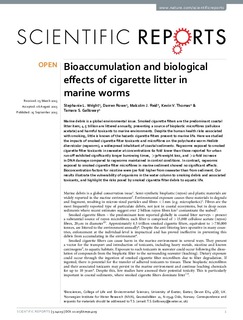| dc.contributor.author | Wright, Stephanie L. | |
| dc.contributor.author | Rowe, Darren | |
| dc.contributor.author | Reid, Malcolm James | |
| dc.contributor.author | Thomas, Kevin V | |
| dc.contributor.author | Galloway, Tamara S. | |
| dc.date.accessioned | 2018-08-01T08:00:53Z | |
| dc.date.available | 2018-08-01T08:00:53Z | |
| dc.date.created | 2015-12-08T15:03:50Z | |
| dc.date.issued | 2015 | |
| dc.identifier.citation | Scientific Reports. 2015, 5. | nb_NO |
| dc.identifier.issn | 2045-2322 | |
| dc.identifier.uri | http://hdl.handle.net/11250/2507069 | |
| dc.description.abstract | Marine debris is a global environmental issue. Smoked cigarette filters are the predominant coastal litter item; 4.5 trillion are littered annually, presenting a source of bioplastic microfibres (cellulose acetate) and harmful toxicants to marine environments. Despite the human health risks associated with smoking, little is known of the hazards cigarette filters present to marine life. Here we studied the impacts of smoked cigarette filter toxicants and microfibres on the polychaete worm Hediste diversicolor (ragworm), a widespread inhabitant of coastal sediments. Ragworms exposed to smoked cigarette filter toxicants in seawater at concentrations 60 fold lower than those reported for urban run-off exhibited significantly longer burrowing times, >30% weight loss, and >2-fold increase in DNA damage compared to ragworms maintained in control conditions. In contrast, ragworms exposed to smoked cigarette filter microfibres in marine sediment showed no significant effects. Bioconcentration factors for nicotine were 500 fold higher from seawater than from sediment. Our results illustrate the vulnerability of organisms in the water column to smoking debris and associated toxicants, and highlight the risks posed by smoked cigarette filter debris to aquatic life. | nb_NO |
| dc.language.iso | eng | nb_NO |
| dc.publisher | Nature Publishing Group | nb_NO |
| dc.rights | Navngivelse 4.0 Internasjonal | * |
| dc.rights.uri | http://creativecommons.org/licenses/by/4.0/deed.no | * |
| dc.title | Bioaccumulation and biological effects of cigarette litter in marine worms | nb_NO |
| dc.type | Journal article | nb_NO |
| dc.type | Peer reviewed | nb_NO |
| dc.description.version | publishedVersion | nb_NO |
| dc.rights.holder | The Authors. | nb_NO |
| dc.source.volume | 5 | nb_NO |
| dc.source.journal | Scientific Reports | nb_NO |
| dc.identifier.doi | 10.1038/srep14119 | |
| dc.identifier.cristin | 1298381 | |
| dc.relation.project | Norges forskningsråd: 225203 | nb_NO |
| dc.relation.project | Department for Environment, Food & Rural Affairs: 1-SW-P-N21-000-031-DN--A1-05102 | nb_NO |
| dc.relation.project | Natural Environment Research Council: L007010/1 | nb_NO |
| cristin.unitcode | 7464,0,0,0 | |
| cristin.unitcode | 7464,20,13,0 | |
| cristin.unitname | Norsk institutt for vannforskning | |
| cristin.unitname | Økotoksikologi | |
| cristin.ispublished | true | |
| cristin.fulltext | original | |
| cristin.qualitycode | 1 | |

